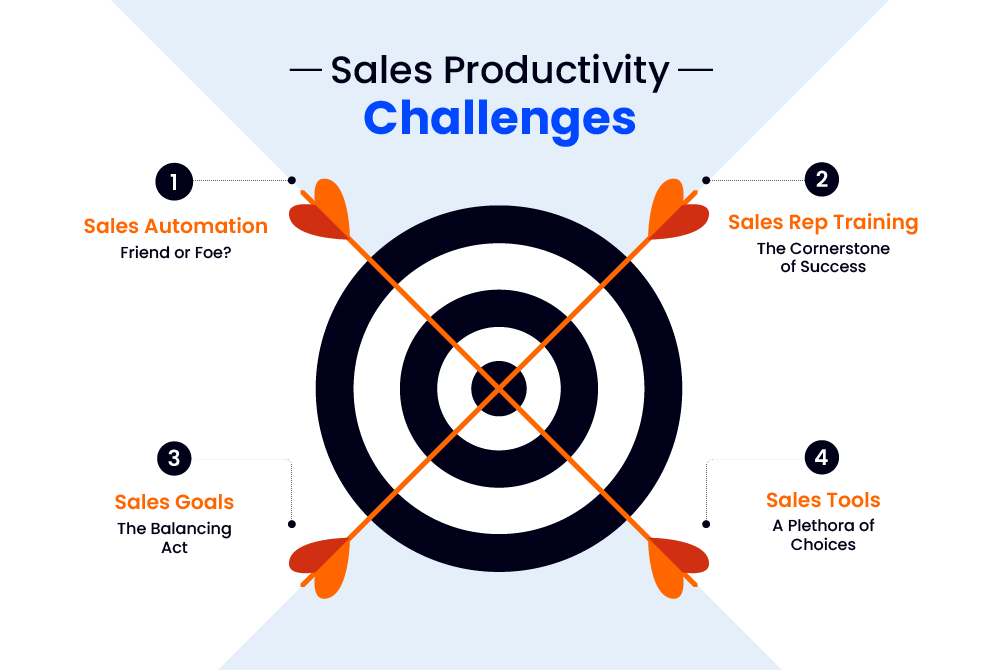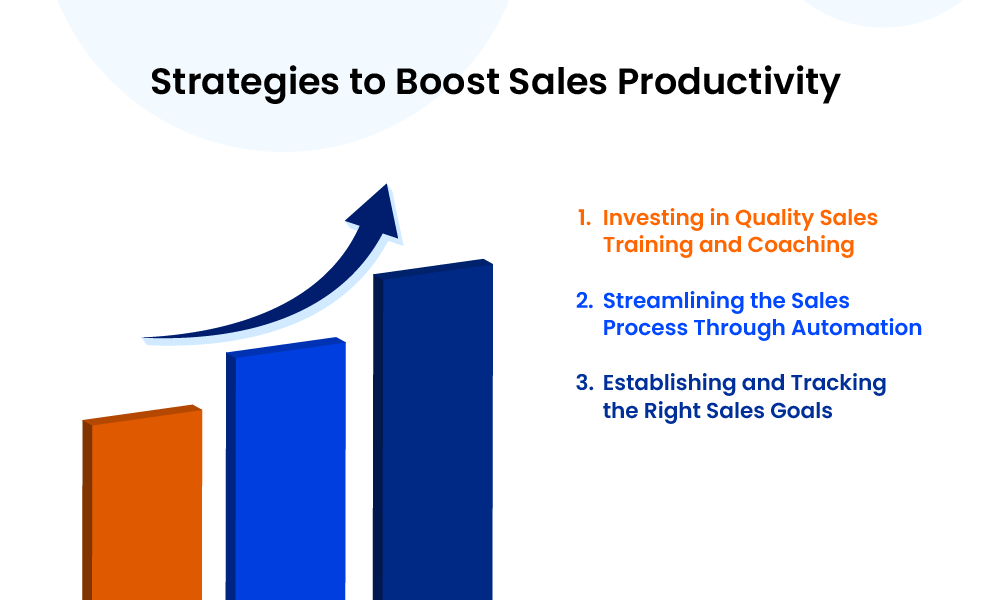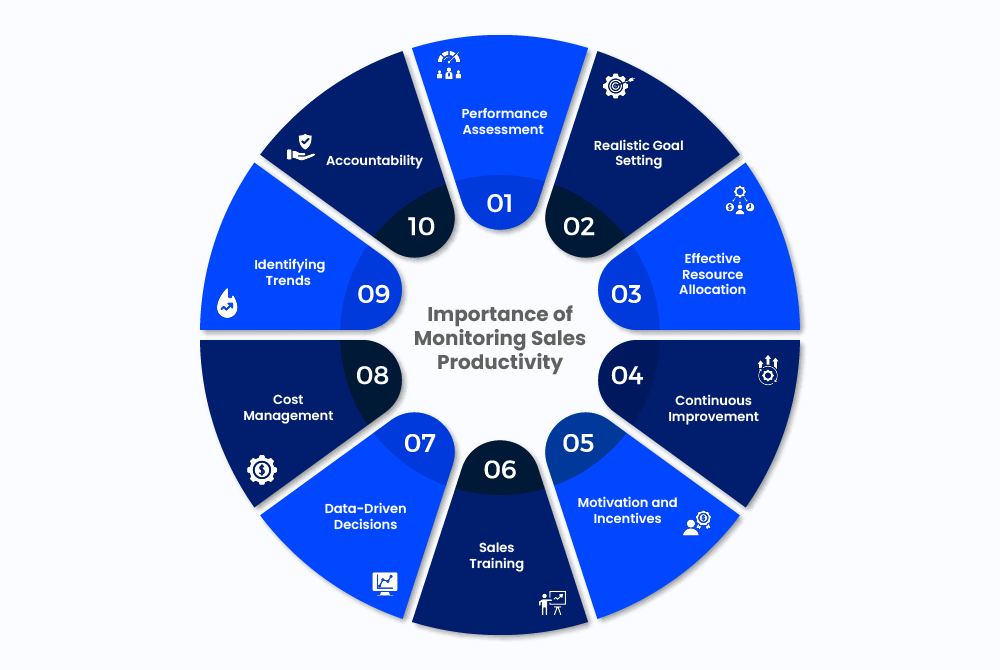In the competitive world of sales, productivity is not just a choice; it’s the very essence of success.
It is not just about making calls and sending emails; it’s about transforming your efforts into tangible results, like closed deals and soaring revenues.
How, you may ask!
In this blog, you’ll understand precisely how to do so and discover insights, actionable advice, and the latest tools to enhance your sales performance.
What is Sales Productivity?
Sales productivity is the measure of how efficiently a sales rep, or an entire sales team transforms their inputs (like time, effort, and resources) into valuable outputs (sales and revenue). The higher your sales productivity, the higher will be the sales numbers and revenue generation.
According to a study by Salesforce, a salesperson spends only 28% of their time on selling activities.
This means that non-selling tasks, like administrative work and data entry often consume a significant portion of a salesperson’s time.
Efficient sales processes can lead to shorter sales cycles and more revenue, as sales teams can close deals faster.
Sales productivity also plays a vital role in enhancing customer engagement, as customers prefer interacting with sales reps who are well-prepared, responsive, and capable of addressing their needs effectively.
Understanding the Importance of Sales Productivity
Picture this: You’re a salesperson, and your day is packed with sales calls, emails, and meetings. Each task demands time and energy, and the pressure to meet targets is always looming. If you’re not productive, you risk feeling like a hamster on a wheel, running tirelessly but getting nowhere.
That is why focusing on sales productivity becomes even more important.
It lies at the core of any successful sales engagement. High sales productivity leads to more closed deals, increased revenue, and satisfied customers. Conversely, low sales productivity can result in missed opportunities, inefficiencies, and declining morale among your sales team.
You’re probably asking, how can you ensure that your hard work translates into success?
Before finding an answer to that, it is important to identify the most common sales productivity challenges.
That would in turn help us understand, measure and enhance our sales productivity.
Identifying Sales Productivity Challenges
While exploring the power of sales productivity, you’ll encounter challenges that might make you question if there’s a better way.
Let’s explore these pain points and discover how to turn them into opportunities.
Sales automation- friend or foe?
Sales automation tools promise efficiency, but do they risk making your interactions feel robotic and impersonal?
It’s a valid concern.
No one wants to be just another number on a salesperson’s list. You want personalized attention, and your customers do too.
Here’s the thing: Sales automation, when used thoughtfully, can be your best friend. It can help you streamline repetitive tasks, giving you more time to nurture valuable relationships. It’s not about replacing human touch but enhancing it.
So, how can you make sure automation serves you, rather than the other way around?
It starts with understanding that every sales email, call and interaction should feel personal. Automation can take care of the mundane, but it’s your job to add the personal touch, turning prospects into valued partners.
Sales rep training- the cornerstone of success
Have you ever felt that your sales team’s skills need to improve, or that you need help to adapt to a rapidly changing market?
You’re not alone. The pain point here is the absence of a structured training and coaching program.
What if we told you that your sales team could continually adapt to market shifts, excel at their jobs, and convert leads more effectively?
The answer lies in investing in a well-trained team that can pivot swiftly in response to market changes and convert more leads into loyal customers.
Sales goals- the balancing act
Setting the right sales goals can be like walking a tightrope.
Too ambitious, and you risk burnout.
Too conservative, and you miss growth opportunities.
Setting sales goals that motivate you rather than overwhelm starts with data.
Analyze your team’s capabilities and your market conditions. By setting specific, measurable, and achievable goals tailored to your team, you keep them motivated, focused, and productive.
Sales tools- a plethora of choices
In the vast landscape of sales tools, it’s very easy to get lost. The fear of making the wrong choice or any inaction can affect your decision-making process. To navigate this sea of choices with confidence, you need to understand your sales process and objectives thoroughly.
Invest in tools that align seamlessly with your workflow Think of these tools as your trusted companions, enhancing your productivity and ensuring you’re always one step ahead of the competition.
Now that we’ve turned challenges into opportunities, let’s explore a range of strategies that will not only boost your sales productivity but make your journey more enjoyable and rewarding.

Strategies to Boost Sales Productivity
1. Investing in quality sales training and coaching
Have you ever envisioned being part of a sales team that actively invests in ongoing training and coaching? Leading organizations view sales training and coaching as an investment rather than an expense. They have well-structured onboarding programs and mentorship initiatives to develop and nurture their sales talent continually.
2. Streamlining the sales process through automation
Automation can be your most valuable ally when used wisely. It frees you from repetitive, time-consuming tasks, allowing you to focus on high-value activities.
When automation takes care of data entry, lead tracking, and follow-ups,your sales team can spend their energy on what they do best: engaging with leads and customers.
The result? Higher engagement and a more productive sales process.
Innovative companies leverage automation tools for streamlined lead management, customer relationship management, and workflow optimization.
For e.g., Amazon, the e-commerce giant, uses an array of automation technologies to optimize its sales operations.
One notable example is its use of recommendation algorithms.
When customers browse and make purchases on Amazon, the platform tracks their behavior and leverages machine learning algorithms to suggest products that are likely to appeal to them. These automated product recommendations are prominently featured on the website and in email communications.
3. Establishing and tracking the right sales goals
Setting and monitoring data-driven, achievable goals are crucial for enhancing sales productivity. Regular assessment and adjustment are also vital for ongoing success.
So, how can you set and monitor the right sales goals?
The answer is data.
Leverage metrics like conversion rates, pipeline velocity, and email engagement. Analyze these to track your progress and make informed decisions. In this data-driven approach, your goals are not mere targets but dynamic milestones that adapt to your team’s capabilities and market conditions.
We have varied options available for exceptional sales productivity tools that can transform your sales operations and be used to apply all of the above-mentioned strategies.

Setting the correct strategies is bound to yield promising results in terms of the benefits that come out of it. Let’s explore some of them.
Benefits of Increased Sales Productivity
Now that we’ve explored the strategies and tools, let’s understand the impact of high sales productivity on businesses and sales teams.
Exploring the business impact of high sales productivity
When considering sales productivity, it’s essential to recognize that its advantages extend far beyond the surface. These benefits have a profound influence on the entire business, contributing to its success in several meaningful ways.
Let’s explore the tangible impacts of enhanced sales productivity:
- Profit Boost: High sales productivity acts as a direct pipeline to greater profits. With more deals closed and increased revenue, it’s akin to a financial booster shot for your business.
- Savings to Spare: Efficient sales processes trim down the cost of acquiring new customers. This is similar to uncovering hidden savings that help your business thrive.
- Faster Wins: Shorter sales cycles mean quicker revenue realization. It’s like sprinting past the competition, reaching the finish line before they even get started.
- Competitive Edge: High sales productivity keeps you firmly in the lead in the market race. You adapt swiftly, meet customer needs proactively, and consistently outperform your competition.
- Wise Resourcing: Prioritizing high-value opportunities ensures your efforts yield the best results.

How enhanced sales productivity improves employee satisfaction
Beyond the numbers, enhanced sales productivity highly impacts the well-being and motivation of your team. It’s a catalyst for improved employee satisfaction.
Here’s how:
- Stress Buster: A streamlined work environment reduces stress levels among your team members. It’s like offering a peaceful oasis amidst the hustle and bustle of the sales world.
- Balance Achieved: Productivity empowers better workload management, leading to a healthier work-life balance for your team. It’s the key to maintaining equilibrium in their professional and personal lives.
- Motivation Power: Productive teams are inherently motivated. They see their efforts directly impact results, boosting job satisfaction.
- Retention Booster: Content employees tend to stay with your company longer, reducing churn rate and the associated recruitment and training costs. It’s a win-win for both your team and your business.
- Team Harmony: Productivity tools foster a collaborative work culture, creating a supportive environment that your employees deeply appreciate. It’s like forging strong bonds within your team.
- Growth Opportunities: A productive environment provides ample room for skill development and career advancement, enhancing job satisfaction and long-term commitment. It’s like a pathway to professional growth and fulfillment.
Sales Productivity Metrics and Evaluation
Measuring and evaluating sales productivity is essential for success in sales, offering a range of benefits. It allows you to assess individual and team performance, set realistic targets, allocate resources effectively, optimize sales strategies, adapt to changing market conditions, and enhance the overall customer experience.
These practices are pivotal in driving sales performance and ensuring your business’s competitiveness in the ever-evolving sales landscape.
Now, let’s focus on how to measure and evaluate your sales productivity effectively, utilizing industry-relevant insights.
Importance of monitoring sales productivity
Measuring sales productivity is not just a number-crunching exercise; it’s a critical practice that provides valuable insights and drives improvement.
Let’s see how:
1. Performance Assessment: Measuring sales productivity allows you to assess how well your sales team is performing. It provides a clear picture of individual and team performance, helping you identify strengths and areas that need improvement.
2. Realistic Goal Setting: Without measurements, it’s challenging to set realistic and achievable sales targets. Sales productivity metrics help you set goals that are based on historical data and industry benchmarks, ensuring that your targets are both challenging and attainable.
3. Effective Resource Allocation: Understanding sales productivity helps in allocating resources effectively. You can allocate more resources to high-performing areas, such as top-performing salespeople or strategies, while optimizing or making changes in less productive areas.
4. Continuous Improvement: Measuring sales productivity acts as a feedback mechanism. It helps you identify bottlenecks and areas where improvements are needed. With this feedback, you can make data-driven decisions to enhance your sales processes.
5. Motivation and Incentives: Sales professionals are often motivated by targets and incentives. Measuring productivity provides the data necessary to reward and motivate high achievers, which, in turn, boosts overall team morale and performance.
6. Sales Training: Sales productivity metrics highlight the skills and areas where sales reps may need additional training or support. It ensures that training efforts are focused on the areas that will have the most impact.
7. Data-Driven Decisions: In the era of data-driven decision-making, measuring sales productivity provides a solid foundation for making informed choices regarding sales strategies, resource allocation, and overall business planning.
8. Cost Management: It helps in managing costs effectively. By understanding which sales strategies and efforts are more productive, you can allocate resources to areas that provide the best return on investment.
9. Identifying Trends: Measuring sales productivity over time enables you to identify trends and patterns in your sales processes. This can be invaluable for long-term planning and strategy development.
10. Accountability: Sales productivity metrics hold sales professionals accountable for their performance. It fosters a culture of responsibility and encourages sales reps to meet or exceed their targets.

Next, let’s dive into the key metrics that gauge sales performance and efficiency and are essential for optimizing your team’s output.
Key Metrics to Measure Sales Productivity
Analyzing key metrics for sales productivity offers invaluable insights into what works and what does not. It helps identify strengths, weaknesses and areas of potential growth, enabling informed decision-making to enhance sales strategies and maximize revenue.
Let’s see what they are:
- Conversion Rates: This metric indicates the percentage of leads or prospects that convert into paying customers. A high conversion rate reflects efficient sales processes.
- Average Deal Size: Knowing the average deal size helps in understanding the value of each transaction, allowing you to focus on high-value opportunities.
- Lead Response Time: A prompt response to leads is crucial. Measuring how quickly your team responds to inquiries can improve lead conversion rates.
- Quota Attainment: Measuring how well your team meets or exceeds their sales quotas is a critical metric for sales productivity.
- Customer Acquisition Cost (CAC): CAC represents the cost of acquiring a new customer. Lowering this cost while maintaining productivity is a key goal.
- Customer Churn Rate: Understanding the rate at which customers leave or “churn” can help improve customer retention strategies.
- Email Engagement: Tracking email open and click-through rates provides insights into the effectiveness of your email campaigns.
Based on all the information till now, we understand that increasing sales efficiency and effectiveness is key in today’s competitive landscape, and leveraging the right sales productivity tools can make all the difference.
So, let’s explore some of those tools that can revolutionize your sales strategy and elevate your business.
Sales Productivity Tools
1. CRM Software
When considering a CRM software, it’s important to look for easy usability, scalability, integrations with your current tools and a robust set of features aligning with your sales processes.
Let’s take a look at such software, their services, pricing and ratings:
Salesforce: Salesforce is a leading CRM platform known for its comprehensive suite of features, including sales management, customer service, marketing automation, analytics, and app development. Its functionalities span lead management, opportunity tracking, workflow automation, customer service management, and AI-powered analytics.
- Pricing: Starting at around 25$/user/month and ranging upto $1250/month (upto 10000 contacts)
- Rating: 4.3/5 (G2)
HubSpot: HubSpot offers a suite of tools including CRM (Customer Relationship Management), marketing automation, email marketing, social media management, content management, lead nurturing, analytics, and sales automation. These features streamline marketing efforts, enhance customer interactions, and optimize sales processes for businesses.
- Pricing: Starting from $1600/month and ranging upto $5000/month.
- Rating: 4.4/5
2. Email tracking and automation
To maximize the output from email tracking and automation, you should consider features like email templates, tracking, analytics and integration capabilities with your CRM system.
Outreach: Outreach is a powerful sales engagement platform offering sales automation, email sequencing, analytics, and AI-driven insights. Its features include multi-channel outreach, personalized email campaigns, sales analytics, and workflow automation, optimizing sales team productivity.
- Pricing: Available upon request
- Rating: 4.3/5 (G2)
Mailchimp: Mailchimp is a popular email marketing platform that offers a range of features including email campaign creation, audience management, marketing automation, analytics, and CRM integration. Its functionalities cover email template designs, audience segmentation, A/B testing, reporting, and integrations with various third-party applications.
- Pricing: Offers free plans and paid tiers from $9.99/month
- Rating: 4.4/5
3. Lead management tools
Prioritize tools that offer lead scoring, segmentation and pipeline management to streamline lead nurturing and conversion.
LeadSquared: LeadSquared is a robust marketing automation and CRM platform that integrates lead capture, tracking, nurturing, and analytics. Its features include lead capture forms, lead scoring, email marketing, sales tracking, workflow automation, and robust analytics. LeadSquared facilitates efficient lead management and accelerates sales conversions by providing insights into customer behavior and automating marketing and sales processes.
- Pricing: Starting from Rs. 1250/user/month and ranging upto Rs. 5000/user/month
- Rating: 4.5/5 (G2)
Zoho CRM: Zoho CRM is a comprehensive customer relationship management software designed to streamline sales, marketing, and support processes. Its features encompass contact management, lead generation, sales pipeline management, marketing automation, workflow automation, analytics, and multichannel communication..
- Pricing: Starting from Rs. 800/user/month and ranging upto Rs. 2600/user/month
- Rating: 4/5
4. Sales enablement software
It is also important to focus on features such as content management, training, analytics and ease of content sharing for sales teams.
Highspot: Highspot is a leading sales enablement platform offering robust features like content management, sales content optimization, sales guidance, analytics, and training. It empowers sales teams by centralizing content, providing AI-driven recommendations, delivering training materials, and enabling analytics-driven insights.
- Pricing: Available upon request
- Rating: 4.7/5 (G2)
Seismic: Seismic is an advanced sales enablement platform specializing in content management, sales content automation, personalized content recommendations, analytics, and sales enablement services. Its features include content creation, automation, and distribution, ensuring sales teams have access to the most up-to-date and personalized content.
- Pricing: Available upon request
- Rating: 4.7/5
LeadSquared excels across all such sales functionalities and emerges as one of the most trusted sales productivity tools.
It offers an all-in-one solution for CRM, email, analytics, and more, streamlining your sales process and saving your valuable time.
Let’s dive into some of its features for increased sales productivity:
1. Lead Management
LeadSquared streamlines lead management, making it easier to capture, nurture, and convert leads. It ensures that sales teams have access to a centralized database of leads, with detailed information on each lead’s interactions and preferences. This enables sales reps to prioritize leads effectively, resulting in higher conversion rates.
2. Workflow Automation
The platform allows you to automate repetitive and time-consuming tasks. For example, you can set up automated email drip campaigns, appointment scheduling, and lead assignment. This reduces manual work and ensures that leads are engaged at the right time with personalized content.
3. Sales Pipeline Management
LeadSquared provides a clear view of your sales pipeline, allowing you to track deals, understand their status, and identify bottlenecks. This transparency helps sales teams focus on high-value opportunities and ensures that deals progress smoothly through the sales process.
4. Sales Analytics
The platform offers robust analytics and reporting tools. Sales managers can track key performance metrics, such as conversion rates, deal velocity, and email engagement. This data-driven approach enables better decision-making and continuous improvement.
5. Lead Scoring
LeadSquared includes lead scoring capabilities that help you prioritize leads based on their engagement and behavior. High-scoring leads are identified as hot prospects, allowing your sales team to concentrate their efforts where they are most likely to yield results.
6. Integration
The platform can integrate with other essential tools and services, such as cloud telephony, chatbots, lead-capture&marketing, analytics, etc. This ensures that all sales and marketing data are synchronized, reducing data entry and improving collaboration between teams.
7. Mobile Accessibility
LeadSquared offers mobile apps, allowing sales reps to access and update information while on the go. This flexibility is invaluable for field sales teams and ensures that leads are never left waiting.
8. Lead Nurturing
The platform supports lead nurturing efforts by enabling personalized and automated follow-ups through email and other channels. This keeps leads engaged and moves them closer to a buying decision.
As a result of an effective use of all the above-mentioned functionalities, LeadSquared helped 22Yards, an app that helps aspiring cricketers pursue a career in the sport, increase their sales productivity too.
22Yards loves LeadSquared because it:
- Streamlined sales workflows
- Automated lead management
- Provided insightful reports and analytics
- Is easy to implement and use
Want to know how it can work for your business?
In Conclusion
The process of boosting sales productivity is a dynamic one and here, adaptability is key
Prioritize your customers and be open to new tools and strategies. Achieving high sales productivity takes time, but with the right approach and tools, significant results are possible.
So, go ahead, implement these tips, and explore the best sales productivity tools available, bearing in mind industry practices and insights.
FAQs
Imagine you’re a sales rep closing deals at an average rate of one per day. After analyzing your sales data and identifying bottlenecks, you implement a more efficient outreach strategy, resulting in closing two deals a day. Your sales productivity has doubled, leading to increased revenue and personal satisfaction.
Companies can measure sales productivity by tracking key metrics like revenue generated, conversion rates, and lead response times. By implementing sales analytics tools and regular performance evaluations, they gain insights into their team’s effectiveness and identify areas for improvement, ensuring enhanced productivity and business success.
seamless integration with existing systems, user-friendliness, scalability, and the extent to which the tool automates repetitive tasks, streamlines workflows, and provides valuable analytics for data-driven decision-making.









